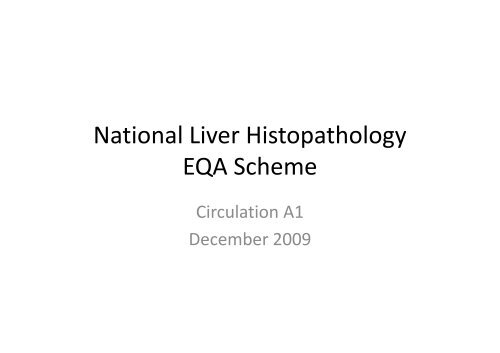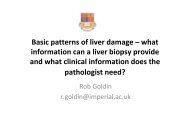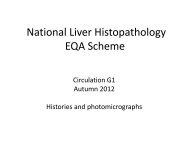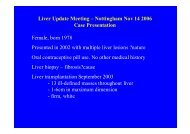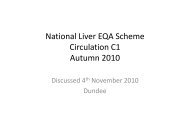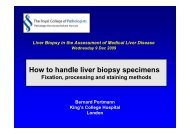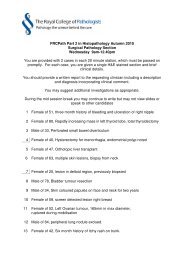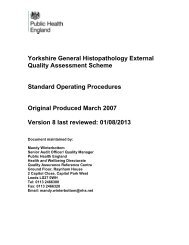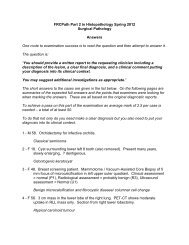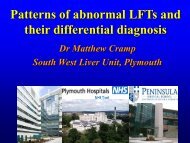National Liver Histopathology EQA Scheme
EQA Meeting Discussion for circulation A1 - Virtual Pathology at the ...
EQA Meeting Discussion for circulation A1 - Virtual Pathology at the ...
You also want an ePaper? Increase the reach of your titles
YUMPU automatically turns print PDFs into web optimized ePapers that Google loves.
<strong>National</strong> <strong>Liver</strong> <strong>Histopathology</strong><br />
<strong>EQA</strong> <strong>Scheme</strong><br />
Circulation A1<br />
December 2009
Circulation A1, meeting 10.12.09<br />
• Present were 30 members and 9 guests<br />
• Of members present, 6 had been unable to view the slides<br />
and send responses because the slides had not been sent to<br />
them in time. If you have slides at a busy time, please send<br />
straight on to the next person in your cell and inform Sophia,<br />
who will re-arrange the circulation.<br />
• Responses with marks deducted are shown in brown italics in<br />
the slides below, and explanation and discussion on the<br />
following slide.
Case 326<br />
Female 76 years<br />
4 week history of painless jaundice.<br />
Bili12umol/L, ALT 40iu/L, AP 349iu/L, alb 41g/l, GGT<br />
498ui/L, negative for HBV, HCV,.<br />
Immunology: ANA 160, other serology negative<br />
(AMA, LKM etc.) IgG 23.4g/L (6-13) IgA 8.73g/L<br />
(0.8-3)
326
326
326
326
326
326
326
326<br />
Responses<br />
Morphology:<br />
19 acute hepatitis<br />
11 acute hepatitis with bridging or<br />
confluent necrosis<br />
14 hepatitis<br />
7 chronic active hepatitis<br />
1 active hepatitis<br />
2 overlap autoimmune<br />
hepatitis/cholangitis<br />
1 hepatitis secondary to SLE<br />
(only diagnosis)<br />
1 autoimmune cholangitis (no<br />
mention of hepatitis)<br />
34 any of above with specific<br />
mention of prominent plasma<br />
cells<br />
Aetiology:<br />
19 autoimmune hepatitis with no<br />
differential<br />
25 autoimmune hepatitis most<br />
likely<br />
25 differential includes drugs<br />
10 differential includes viral<br />
hepatitis<br />
5 autoimmune hepatitis among<br />
differential, not most likely<br />
1 lupoid hepatitis, no differential<br />
1 no mention of autoimmune<br />
hepatitis in differential
326<br />
Scoring and discussion.<br />
Score 5 points for any answer including hepatitis except as indicated above. This case<br />
showed confluent bridging necrosis which is an important indicator of severity and<br />
should be included in the report. Chronicity requires connective tissue stains for<br />
accurate evaluation, so points were not deducted for diagnoses of chronic disease,<br />
although the consensus for this case was of acute disease. There were no<br />
histological or clinical features to suggest overlap with biliary disease. Hepatitis is<br />
rarely a component of the multisystem disease of SLE, and the serology given does<br />
not point to SLE.<br />
Prominent plasma cells are an important feature contributing to the overall clinical<br />
diagnosis of autoimmune hepatitis and should be included in the report, but was<br />
not included in the <strong>EQA</strong> scoring.<br />
Aetiology: 5 points deducted for failure to include autoimmune in the diagnosis;<br />
lupoid hepatitis is an old terminology, and may be misleading – the current<br />
terminology is for a diagnosis of autoimmune hepatitis with additional comment<br />
on severity of necrosis, interface activity and chronicity.
326<br />
Submitting pathologist’s diagnosis:<br />
Autoimmune hepaititis with bridging fibrosis<br />
Follow up: after the biopsy the patient received prednisolone and<br />
azathioprine, and the LFTs returned to normal, confirming the diagnosis of<br />
autoimmune hepatitis.
Case 327<br />
Female 61 years<br />
Unexpected cirrhosis at lap chole
327
327
327
327
327
327
327<br />
Responses<br />
16 nodular regenerative hyperplasia as definite diagnosis<br />
11 possible nodular regenerative hyperplasia<br />
3 possible or definite cirrhosis, as morphological diagnosis<br />
4 cirrhosis, likely clinical diagnosis despite not being<br />
confirmed by this biopsy<br />
11 non-diagnostic biopsy, needs special stains<br />
4 chronic biliary disease/obstruction<br />
1 primary biliary cirrhosis<br />
1 hepatoportal sclerosis<br />
1 hyperplastic nodular process<br />
1 no specific abnormality, fatty change only<br />
1 lipogranulomas (as main diagnosis)<br />
1 amyloid<br />
2 iron overload and mild steatosis<br />
Case not scored
327<br />
Scoring and discussion:<br />
This case had insufficient consensus for scoring.<br />
The submitted and most popular diagnosis was nodular<br />
regenerative hyperplasia. It was commented that<br />
macronodular cirrhosis could not be completely excluded by<br />
needle biopsy, and more clinico-pathological correlation was<br />
required to reach a diagnosis in this case.<br />
Submitting pathologist’s diagnosis:<br />
Nodular regenerative hyperplasia
Case 328<br />
Female 53 years<br />
Lateral left liver lobe cyst ?cystadenoma<br />
Specimen: Lateral liver lobectomy<br />
Macroscopic description: Partial hepatectomy<br />
containing a unilocular cyst 100X85mm in<br />
which abundant red/brown material is present.<br />
Background liver looks normal.
328
328
328
328
328
328<br />
Responses<br />
14 primary biliary cystic tumour, no differential diagnosis<br />
17 biliary cystic tumour, differential diagnosis including<br />
metastatic thyroid carcinoma<br />
4 metastatic thyroid carcinoma with differential diagnosis<br />
1 metastatic papillary carcinoma, differential pancreas, kidney,<br />
lung, thyroid<br />
14 metastatic thyroid carcinoma, no differential given but<br />
immunohistochemistry requested<br />
5 metastatic thyroid carcinoma, no immunos.
328<br />
Scoring and discussion<br />
Discussion over whether there was sufficient consensus to<br />
include scoring on this case. Members voted to accept<br />
diagnoses that included the possibility of metastatic<br />
carcinoma. The clear, overlapping nuclei of the papillary<br />
tumour were very characteristic of papillary thyroid<br />
carcinoma.<br />
Further information from submitting pathologist – this patient<br />
had a thyroid FNA showing papillary carcinoma two weeks<br />
before this surgery – there was a lack of communication of<br />
this result between clinical teams. The tumour is<br />
immunohistochemically positive for TTF.<br />
Submitting pathologist’s diagnosis: metastatic papillary<br />
carcinoma of the thyroid
Case 329<br />
Female 79 years<br />
Presented with cholestatic liver function tests<br />
with an ALP of 319. Known to have conjestive<br />
cardiac failure. <strong>Liver</strong> screen normal. Not obese.<br />
CT scan showed no evidence of biliary dilation
329
329
329
329
329<br />
Responses<br />
30 amyloid, includes clinical comment about need for investigation of<br />
cause<br />
21 amyloid, no comment about clinical investigation<br />
2 amyloid or light chain disease<br />
1 cardiac cirrhosis, need to exclude amyloid, do congo red<br />
1 pseudo-amyloidosis ? cause, not typical of cardiac cirrhosis or<br />
amyloid.<br />
Comment: several suggested cardiac failure may be due to cardiac<br />
amyloid<br />
Several commented on bilirubinostasis.
329<br />
Scoring and discussion<br />
All responses scored 10.<br />
Congo red confirmed the diagnosis of amyloid. There is no<br />
indication of the type – immunohistochemistry for kappa and<br />
lamda both positive. The patient did not survive long. The<br />
possibility of cardiac involvement by amyloidosis was raised at<br />
the time, but was not further investigated.<br />
Submitting pathologist’s diagnosis: hepatic amyloidosis
Case 330<br />
Female 47 years<br />
Known ulcerative colitis, elevated alk phos.<br />
?PSC/other pathology
330
330
330
330
330
330
330
330<br />
Responses<br />
34 venous outflow obstruction/Budd Chiari syndrome<br />
1 veno-occlusive disease as only diagnosis<br />
1 sinusoidal obstruction syndrome<br />
1 obstructive portal venopathy<br />
1 peliosis<br />
1 portal vein thrombosis<br />
2 nodular regenerative hyperplasia<br />
1 sinusoidal obstruction suggestive of portal vein thrombosis<br />
12 no mention of vascular abnormality<br />
Of which: 9 PSC definite, or consistent with, as only diagnosis<br />
1 ductopaenia, ?sclerosing cholangitis<br />
1 minimal chronic hepatitis, PSC not excluded<br />
1 description, no diagnosis,<br />
1 PSC main diagnosis, ? recent viral hepatitis<br />
2 PSC as secondary diagnosis<br />
1 ? early PBC check autoantibodies<br />
8 PSC possible, not excluded<br />
18 specifically commented on absence of features of PSC<br />
12 no mention of PSC<br />
Case not scored
330<br />
Scoring and discussion<br />
Case not suitable for scoring – too complicated.<br />
This is a good example of the clinically important features of venous<br />
outflow obstruction. The zone 3 hepatocyte loss and red cell<br />
extravasation characteristic of Budd Chiari syndrome are well seen.<br />
This led to imaging and pressure studies which confirmed the<br />
diagnosis of Budd Chiari syndrome. The hepatic vein was stented<br />
and the patient is on warfarin and remains well. ? evidence for PSC<br />
as well??<br />
Submitting pathologist’s diagnosis: Budd Chiari syndrome
Case 331<br />
Female 64 years<br />
Haemochromatosis, 3 litres drained from<br />
ascites
331
331
331
331
331
331
331<br />
Responses<br />
54 cirrhosis<br />
1 cirrhosis not mentioned<br />
54 haemochromatosis<br />
1 siderosis (not further qualified)<br />
9 specifically commented on absence of<br />
dysplasia/malignancy<br />
7 also ? fatty liver disease<br />
1 large cell dysplasia
331<br />
Scoring and discussion<br />
Both cirrhosis and haemochromatosis needed to be included for<br />
full marks.<br />
Submitting pathologist’s diagnosis: cirrhosis, haemochromatosis
Case 332<br />
Female 55 years<br />
<strong>Liver</strong> resection for adenoma<br />
Specimen: <strong>Liver</strong> resection<br />
Macroscopic description: Nodular segment of<br />
liver measuring 3.8x2x1.8cm. on section<br />
there was a multinodular lesion 2.2x2x.1.4cm
332
332
332
332
332<br />
Responses<br />
52 focal nodular hyperplasia<br />
1 FNH or FNH-like adenoma<br />
1 benign liver adenoma<br />
1 follicular nodular hyperplasia
332<br />
Scoring and discussion<br />
This case showed unequivocal characteristic features of a focal nodular<br />
hyperplasia, including stellate fibrosis with thick walled artery,<br />
ductular reaction and chronic inflammation.<br />
Score 0 for adenoma or ‘FNH or FNH-like adenoma’ – this case did not<br />
have the features of a telangiectatic FNH, the type of FNH which is<br />
now re-classified as an adenoma. Score 5 marks for ‘follicular<br />
nodular hyperplasia’ – presumed a typographical error.<br />
Submitting pathologist’s diagnosis:<br />
Focal nodular hyperplasia
Case 333<br />
Female 34 years<br />
Acute abnormal LFT’s. Increased IgG<br />
(40).Positive ANA and SMA. Negative other<br />
serology. Likely autoimmune hepatitis
333
333
333
333
333
333<br />
Responses<br />
Morphology:<br />
6 acute hepatitis<br />
17 acute hepatitis with bridging/confluent necrosis<br />
12 hepatitis,<br />
4 acute on chronic hepatitis<br />
10 chronic active hepatitis<br />
4 chronic hepatitis<br />
1 autoimmune hepatitis and cirrhosis<br />
1 lupoid hepatitis<br />
37 specifically commented on prominence of plasma cells<br />
Aetiology:<br />
40 Autoimmune hepatitis as only diagnosis<br />
9 autoimmune hepatitis as main diagnosis, with differential<br />
1 lupoid hepatitis<br />
4 autoimmune hepatitis/primary biliary cirrhosis overlap
333<br />
Scoring and discussion<br />
For full marks, needed mention of activity of hepatitis, and of<br />
autoimmune aetiology. Responses with chronic hepatitis or<br />
cirrhosis without a comment on activity of disease were<br />
deducted 5 marks. Lupoid hepatitis is obsolete terminology,<br />
replaced by autoimmune hepatitis. There were neither<br />
histological or clinical features to suggest an additional<br />
component of an overlap syndrome with PBC.<br />
Submitting pathologist’s diagnosis: florid autoimmune hepatitis<br />
with prominent confluent /submassive necrosis
Case 334<br />
Male 34 years<br />
Hepatitis B positive. Fatty liver? Cause.
334
334
334
334
334
334
334
334<br />
Responses<br />
3 Chronic hepatitis, NOS<br />
18 chronic hepatitis, minimal<br />
28 chronic hepatitis, mild<br />
1 hepatitis B carrier<br />
1 ‘hepatitis B infection’ – no mention of chronic hepatitis histologically<br />
1 no portal or acinar inflammation<br />
1 ‘no portal or parenchymal inflammation. No evidence of NASH or active hepatitis B<br />
hepatitis’<br />
1 ‘no changes of active viral hepatitis’ (ground glass not mentioned)<br />
50 ground glass hepatocytes / hepatitis B mentioned<br />
4 ground glass/hepatitis B not mentioned<br />
45 steatosis, mild<br />
1 steatosis, moderate<br />
3 steatosis, NOS<br />
1 no steatosis<br />
1 steatohepatitis<br />
1 micro and macrovesicular steatosis, ? drug<br />
2 steatosis not mentioned
334<br />
Scoring and discussion<br />
For full marks, responses needed to include the presence of<br />
chronic hepatitis, ground glass hepatocytes, and steatosis.<br />
Although mild there was sufficient portal inflammation in some<br />
portal tracts to support a diagnosis of chronic hepatitis. The<br />
clinical information queried fatty liver, and a comment on the<br />
presence of steatosis was therefore required for full marks.<br />
There were no ballooned hepatocytes or other features of<br />
steatohepatitis.<br />
Submitting pathologist’s diagnosis: minimal chronic hepatitis B,<br />
stage 0, no steatosis
Case 335<br />
Female 25 years<br />
beta Thalassaemia. Increased ferritin
335
335
335
335
335
335<br />
Responses<br />
51iron overload, pattern consistent with transfusion siderosis<br />
3 iron overload NOS<br />
1 no mention of iron<br />
32 fibrosis present<br />
13 no mention of fibrosis<br />
1 ‘not yet cirrhosis’<br />
7 need connective tissue stain to assess fibrosis<br />
33 extra-medullary haematopoiesis<br />
1 ‘haemosiderosis and haemochromatosis, not established<br />
cirrhosis. HFE gene studies’<br />
Few commented on need to exclude hepatitis C<br />
Several - need HFE genetics as well?
335<br />
Scoring and discussion<br />
Full marks for all responses including iron overload. The presence of fibrosis was not<br />
scored, since this was considered to require connective tissue stains for evaluation.<br />
There was evidence of extra-medullary haematopoiesis on the scanned slide<br />
photographed, but it is unknown whether this was present on all slides, and<br />
therefore was not required for full marks.<br />
Discussion – it was presumed that the patient had iron overload following multiple<br />
transfusions because of thalassaemia. The presence of extra-medullary<br />
haematopoiesis supported this, as it implied insufficient bone marrow<br />
haematopoises to keep pace with haemolysis from thalassaemia.<br />
Clinicopathological discussion is required to confirm transfusions.<br />
The distribution of iron in macrophages/Kupffer cells as well as hepatocytes can also<br />
be seen in some inborn errors of iron metabolism e.g. ferropontin/ferroportin<br />
deficiency. Specialist investigations for this are not currently available in the UK –<br />
some members had sent samples to Italy for further investigation. Genetic tests<br />
for haemochromatosis would only be indicated if the iron could not be explained<br />
by multiple transfusions.<br />
Submitting pathologist’s diagnosis: Grade 4 siderosis, Ishak stage 2 fibrosis. Extramdullary<br />
haematopoieses, consistent with stated history.
Case 336<br />
Female 34 years<br />
Non-anatomical resection. Previous partial<br />
excision for simple cyst. This is completion<br />
excision of remainder.<br />
Specimen: <strong>Liver</strong> and gall bladder<br />
Macroscopic description: A- liver cyst-the<br />
specimen weighs 260 grams, comprising<br />
previously opened thick walled unilocular cyst<br />
13 cms in diameter, received in a collapsed<br />
state without contents.
336
336
336
336
336
336<br />
Responses<br />
42 hepatobiliary cystadenoma, with specialised/mesenchumal<br />
stroma<br />
7 hepatobiliary cystadenoma (no mention of stroma)<br />
1 mucinous cystadenoma<br />
1 benign biliary cyst, ? hamartomatous<br />
1 solitary unilocular cyst, biliary epithelium<br />
2 endometriotic cyst<br />
1 adenofibroma or mucinous cystadenoma<br />
24 granuloma/granulomatous hepatitis<br />
27 no mention of granuloma<br />
7 further medical investigations suggested for granulomatous<br />
inflammation<br />
Several attributed granuloma to previous surgery.
336<br />
Scoring and discussion<br />
This cyst wall showed cellular stroma characteristic of<br />
hepatobiliary cystadenoma.<br />
Half the responses did not include mention of the granuloma in<br />
the adjacent liver tissue; it is possible that this feature was not<br />
present in all sections, and so is not included in the scoring<br />
Submitting pathologist’s diagnosis: hepatobiliary cystadenoma<br />
with mesenchymal stroma
Case 337<br />
Female 50 years<br />
Hepatitis C, plus cirrhosis secondary to alcohol.<br />
1cm hypoechoic lesion segment 4, core biopsy
337
337
337
337
337
337
337
337
337<br />
Responses<br />
49 cirrhosis<br />
5 no mention of cirrhosis<br />
44 hepatocellular carcinoma<br />
of which: 14 well differentiated<br />
5 moderately differentiated<br />
25 no grade included<br />
1 probable HCC<br />
7 dysplastic nodule suspicious of HCC<br />
1 liver cell dysplasia (nil else)<br />
2 adenoma vs. Well differentiated HCC<br />
10 ? iron overload, needs Perl’s stain
337<br />
Scoring and discussion<br />
Both the presence of background cirrhosis and of hepatocellular<br />
carcinoma in the biopsy were required for full marks. There were<br />
considered to be sufficient features of HCC (cytological and<br />
architectural) to make the diagnosis on this slide. The presence of<br />
arteries within the lesion, the cytology compared with the<br />
hepatocytes in the background liver, and the large rosettes/pseudo-<br />
acinar pattern were features that supported the diagnosis of HCC.<br />
The differential is with dysplastic nodule, and not with adenoma, in<br />
the context of a cirrhotic liver.<br />
This patient went on to have radio-frequency ablation, but<br />
subsequently developed several other small nodules. For a while<br />
she was within transplant criteria (up to 3 lesions
The end


